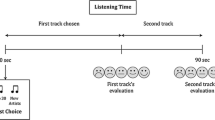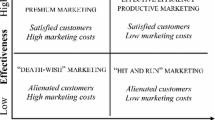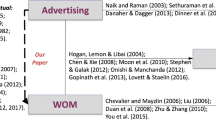Abstract
Weekly sales of creative goods—like music records, movies, or books—usually peak shortly after release and then decline quickly. In many cases, however, they follow a hump-shaped pattern where sales increase for some time. A popular explanation for this phenomenon is word of mouth among a population of heterogeneous buyers, but previous studies typically assume buyer homogeneity or neglect word of mouth altogether. In this paper, I study a model of new-product diffusion with heterogeneous buyers that allows for a quantification of the sales effect of word of mouth. The model includes Christmas sales as a special case. All parameters have an intuitive interpretation. Simulation results suggest that the parameters are estimable for data that are not too volatile and that cover a sufficiently large part of a title’s life cycle. I estimate the model for four exemplary novels using scanner data on weekly sales.



Similar content being viewed by others
Notes
Weekly sales (original hardcover edition), based on scanner data from a large sample of German retailers. Titles are anonymized; see Sect. 4 for a more detailed description of the data.
A related economics literature explains a hump-shaped pattern in the adoption of new technologies, which is equivalent to an S-shaped pattern in their penetration, generally by either decreasing costs or increasing benefits of adoption over time (Hall & Kahn, 2003). These factors—in my application the retail price, for example—are typically constant during the short selling period of a new creative good; however, one may interpret word of mouth as evidence of changes in the (perceived) benefits of adoption.
Applications with more detailed retailer- or consumer-level data are outside the scope of this paper; for such data, discrete choice models are more appropriate. Yet, decision makers other than retailers typically have access only to some kind of aggregated sales data (if any).
The literature on new-product diffusion often focuses on technical innovations such as color television or the washing machine and therefore labels this consumer segment ‘innovators.’ Here, I follow Keller and Berry (2003) and Van den Bulte and Joshi (2006) in using a more generally applicable term.
A formal assumption is that, at each point in time, each influential contacts a different set of imitators. In a continuous-time model, the probability that an imitator is contacted by more than one influential at once should be negligible.
Notice that although the Bass model also reduces to Eq. (1) if its word of mouth parameter equals zero, the two models are not nested.
Exemplary cases are reported in ‘Women buy fiction in bulk and publishers take notice’, New York Times, March 17, 1997.
The potential “deadweight loss” involved with misguided Christmas presents is subject to an academic debate initiated by Waldfogel (1993).
In some applications—including mine, as I discuss in more detail in Sect. 4—it may be difficult to determine the exact release date for the title under consideration. First- and second-week sales figures are then hardly comparable and estimation should be adapted to this problem.
Parameter identification would be complicated if December observations coincided with the early, increasing part of a title’s sales curve. In practice, the vast majority of popular books is released with a safe distance to Christmas between spring and early fall. Presumably, the fact that the book season starts with the book fair in October is an effort to animate word of mouth early enough such that it can boost Christmas sales.
Boswijk and Franses (2005) propose an alternative estimation method for the Bass model based on weighted least squares and argue that it has better properties than the NLS approach, which has been implemented widely in similar applications. However, their approach is not applicable to the proposed diffusion model in a straightforward manner.
If v t is normally distributed with mean \({-\frac{\sigma^2}{2}}\) and variance σ2, then u t = exp(v t ) is log-normally distributed with mean 1 and variance exp(σ2)−1.
This particular cutoff value for \({\hat{M}}\) is not pivotal, since most degenerate sets of estimates come with M-estimates in the 6-digit range or higher.
More detailed simulation results, such as kernel density plots of the distribution of estimates, can be found in the appendix of Beck (2006b).
Many titles in this random sample have low overall sales and zero sales in many observed weeks, but a significant number of titles exhibits hump-shaped sales.
According to the raw data, single copies of title 1 and 3 were sold two and three weeks before sales of the respective title took off (with 33 and 129 copies sold in that week, respectively). I treated these early sales as erroneously booked advance orders and hence assumed that 34/130 copies were sold in the respective title’s release week.
I include the R 2 measure only to compare fit across titles. High R 2 values are common in nonlinear models and not per se suggestive of a good specification (Trajtenberg & Yitzhaki, 1989).
References
Bass, F. M. (1969). A new product growth model for consumer durables. Management Science, 15(5), 215–227.
Beck, J. (2006a). Fixed, focal, fair? Book prices with optional resale price maintenance. Working paper.
Beck, J. (2006b). The sales effect of word of mouth: A model for creative goods and estimates for novels. WZB Discussion Paper SP II 2006-16.
Bemmaor, A. C., & Lee, J. (2002). The impact of heterogeneity and ill-conditioning on diffusion model parameter estimates. Marketing Science, 21(2), 209–220.
Boswijk, H. P., & Franses, P. H. (2005). On the econometrics of the Bass diffusion model. Journal of Business & Economic Statistics, 23(3), 255–268.
Canoy, M., van der Ploeg, F., & van Ours, J. C. (2006). The economics of books. In V. Ginsburgh, & D. Throsby (Eds.), Handbook on the economics of art and culture. Elsevier.
Caves, R. E. (2000). Creative industries. Cambridge, MA: Harvard University Press.
Chevalier, J.,& Goolsbee A. (2003). Price competition online: Amazon versus Barnes and Noble. Quantitative Marketing and Economics, 1(2), 203–222.
Chevalier, J. A., & Mayzlin, D. (2006). The effect of word of mouth on sales: Online book reviews. Journal of Marketing Research, 43(3), 345–354.
De Vany, A. S., & Walls, W. D. (1996). Bose-Einstein dynamics and adaptive contracting in the motion picture industry. The Economic Journal, 106(439), 1493–1514.
De Vany, A. S., & Walls, W. D. (2004). Motion picture profit, the stable Paretian hypothesis, and the curse of the superstar. Journal of Economic Dynamics and Control, 28(6), 1035–1057.
Elberse, A., Eliashberg, J., & Leenders, M. (2006). The motion picture industry: Critical issues in practice, current research and new research directions. Forthcoming in Marketing Science.
Franses, P. H. (2002). Testing for residual autocorrelation in growth curve models. Technological Forecasting & Social Change, 69(2), 195–204.
Geroski, P. A. (2000). Models of technology diffusion. Research Policy, 29(4–5), 603–625.
Hall, B. H., & Khan, B. (2003). Adoption of new technology. In D. C. Jones (Ed.), New economy handbook. Academic Press.
Keller, E. B., & Berry, J. (2003). The influentials. The Free Press.
Mahajan, V., Muller, E., & Wind, Y. (Eds.) (2000). New-product diffusion models. New York, NY: Springer.
Moe, W. W., & Fader, P. (2001). Modeling hedonic portfolio products: A joint segmentation analysis of music compact disc sales. Journal of Marketing Research, 38(3), 376–385.
Moul, C. C. (2006). Measuring word of mouth’s impact on theatrical movie admissions. Forthcoming in the Journal of Economics & Management Strategy.
Putsis, W. P. J., & Srinivasan, V. (2000). Estimation techniques for macro diffusion models. In Mahajan, Muller and Wind (2000), pp. 263–294.
Rogers, E. M. (1995). Diffusion of innovations. New York: The Free Press.
Sorensen A. T. (2006). Bestseller lists and product variety. Forthcoming in the Journal of Industrial Economics.
Sorensen A. T., & Rasmussen, S. (2004). Is any publicity good publicity? A note on the impact of book reviews. Working paper.
Trajtenberg, M. & Yitzhaki, S. (1989). The diffusion of innovations: a methodological reappraisal. Journal of Business & Economic Statistics, 7(1), 35–47.
Van den Bulte, C., & Joshi, Y. V. (2006). New product diffusion with influentials and imitators. Forthcoming in Marketing Science.
Van den Bulte, C., & Lilien, G. L. (1997). Bias and systematic change in the parameter estimates of macro-level diffusion models. Marketing Science, 16(4), 338–353.
Waldfogel, J. (1993). The deadweight loss of Christmas. American Economic Review, 83(5), 1328–1336.
Author information
Authors and Affiliations
Corresponding author
Additional information
I benefitted from detailed comments by Michal Grajek, Holger Stichnoth, Christophe Van den Bulte, and an anonymous reviewer, discussions with Lars-Hendrik Röller and participants at the Vienna ACEI Conference, the Pittsburgh INFORMS Marketing Science conference and the WZB seminar, as well as proof-reading by Christopher Xitco. All remaining errors are mine. I am grateful to Media Control GfK International and Uwe Maisch for data provision and to the Börsenverein des Deutschen Buchhandels for permission to use it. I gratefully acknowledge the financial support from the German Federal Ministry of Education and Research, project InterVal (01AK702A), and the hospitality of the Economics group at London Business School.
Rights and permissions
About this article
Cite this article
Beck, J. The sales effect of word of mouth: a model for creative goods and estimates for novels. J Cult Econ 31, 5–23 (2007). https://doi.org/10.1007/s10824-006-9029-0
Received:
Accepted:
Published:
Issue Date:
DOI: https://doi.org/10.1007/s10824-006-9029-0




